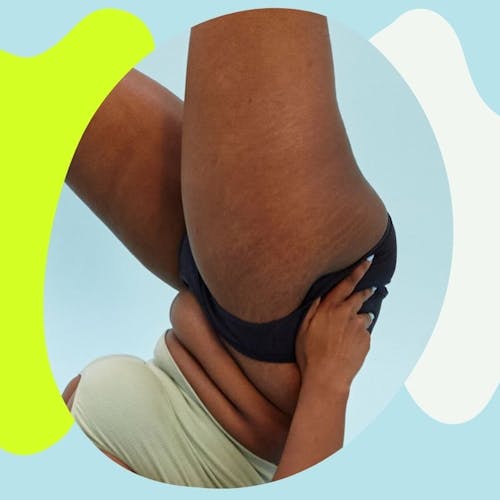This website uses cookies to enhance the user experience. By using Yoppie you are agreeing to our use of cookies.
Trouble "Getting Wet?" Here's What's What
Written by Yoppie
16 Feb 2020
What types of discharge are there? 💦
What is abnormal discharge? 🤔
How to find and feel your cervical fluid 💧
How does your cycle affect discharge? 🩸
The science of getting ‘wet’ 🤓
Why do you sometimes get wet without the arousal? ✨
Today’s article looks drizzly with a chance of showers and a few dry spells, and we’re on board for all of it. Yes, we’re talking all things discharge, arousal fluid, lubricants, and all that juicy stuff.
Firstly let’s clarify how ‘getting wet’ is different from discharge; ‘wetness’ often refers to when someone is aroused and their vagina produces fluid to make it easier for a penis to slip on in there, while ‘discharge’ (otherwise known as leukorrhea), is a general term used for anything fluid-like that emerges from the vagina.
So before we discuss the sexy stuff, we should clear up what discharge actually is.
What types of discharge are there? 💦
Discharge comes in all consistencies, colours and volumes, and everyone experiences a different type of discharge down there. For the most part, it’s pretty normal. Here’s a vagina vocab lesson:
- Discharge: a general term for all the fluids you see leaving in the vaginal fluid. This is usually made up of cervical mucus and bacteria
- Cervical fluid: a type of discharge originating from the cervix, which changes at specific points in your menstrual cycle. Its job changes throughout the month to either encourage or stop sperm from passing through the cervix.
- Arousal fluid: Don't be fooled by its incredibly un-sexy name; this is the body's response to being turned on (or in some cases, a response inconveniently triggered for no reason at all)
Feeling fluids come out of your vagina is nothing to worry about, as it’s your vagina’s way of naturally cleaning itself. However, being tuned in to your own discharge characteristics, patterns and where they appear in your cycle is always positive, as this makes it easier to notice changes and spot any abnormalities if they come up (or, erm… out).
What is abnormal discharge? 🤔
There’s a whole ecosystem in your vagina (cool, right?) maintaining a fine balance of bacteria and a specific pH to keep it healthy (2). Changes to this can lead to changes in your vaginal fluid, meaning possible issues, so knowing typical colours to watch for is advised.
Whether it’s clear, white, yellow, green, red, pink or even grey, you’ll want to understand what could be going on inside to cause this. Significant changes in colour, consistency or smell could indicate you need to get a GP checkup.
How to find and feel your cervical fluid 💧
If you want to get to know your cervical fluid, you can use your fingers to feel for fluid at the entryway to your vagina, or at your cervix directly.
When you feel, consider feeling for changes in the consistency (e.g. pasty, slippery), amount, and colour of the fluid, along with the sensation at your vaginal opening (like whether it is wet or dry).
Another way is to look for fluid on your toilet paper. Cervical fluid is often visible on the paper and typically looks a little different from other vaginal moisture, because of its thickness and consistency.
Also be aware that it’s possible to confuse ejaculate (semen) or arousal fluid for cervical fluid, even up to a day after sex!
How does your cycle affect discharge? 🩸
You’ll typically experience up to a teaspoon’s worth (around 1-4 mL) daily of clear or white discharge, but this can fluctuate throughout your menstrual cycle, particularly if you’re not on hormonal birth control. As oestrogen and progesterone levels rise and fall, your body is essentially preparing for a possible pregnancy, and this changes the quality and quantity of your vaginal discharge.
For example, during ovulation, your body increases its oestrogen levels and prepares for the arrival of sperm to fertilise those eggs (otherwise known as sexy time). As a result, additional discharge increases the lubrication for sex and, in theory, makes it easier.
The science of getting ‘wet’ 🤓
Many a porno has made us believe that getting wet is an instantaneous reaction to seeing anything remotely arousing. While this can be true for some, many people would agree that it is neither that simple nor that easy.
“Getting wet” basically means you’re prepped for sex and ready to go. It’s the job of the Bartholin’s glands (next to the vaginal opening) and the Skene’s glands (near the urethra) to produce the natural lubrication needed for sexual activity, and this happens as a physical and psychological response to something that turns you on (5). When this happens, blood rushes to the genital area, increasing sensitivity there.
As mentioned, some people find it easy to get wet, while others find that there are multiple factors at play, such as where they are in their cycle, how much foreplay has gone down, their mental state, stress levels, medications they may be taking (such as hormonal birth control or antidepressants), or something else.
The best thing to do if you’re struggling to feel that wetness you need to get going, is to talk to your partner about what you need, or just use a lubricant to kick-start the process. For many women, common issues such as vaginal dryness after pregnancy or during the menopause can be made instantly more comfortable with something as simple as lubricant, which in turn can increase your own natural arousal. If this feels icky to discuss, know that according to an Indiana University study, 70% of 2,453 women surveyed said lube made sex more pleasurable, so it’s a pretty common option, and nothing to be ashamed of. Lube for all, we say!
Why do you sometimes get wet without the arousal? ✨
We’ve all been there; you’re out and about, minding your own business, and BAM; you need to make a quick trip to the loo to check what’s going on down there. What feels like an unexpected period is sometimes just some random wetness that seemingly comes from nowhere at all. Perhaps your eyes glanced over a poster of Henry Cavill’s new movie. Perhaps you were just reeeally into the doughnut you were eating. Or perhaps it was just… nothing.
Sometimes your body has those moments, and it’s nothing to worry about - your vagina has a lot of sweat and oil glands working to keep things balanced, so random, unidentifiable wetness can often be attributed to this.
Got a question about ‘getting wet’, discharge, or something else vagina-related? Let us know over on Instagram @itsyoppie! We’ll always do our best to get you the answers you need. You've got enough going on even when it's business as usual during the month, so don't forget that our personalised period subscription box can get the essentials delivered through your letterbox as often as you need. Prefer to keep some everyday protection on hand too? Take a look at our super-soft and hypoallergenic organic cotton pantyliners.
Fact checked by Doctor Samantha Miller.
Section jump
Back to top
Subscribe To Our Newsletter
YOPPIE





© 2026 Yoppie is a registered trademark of Phlo Technologies Ltd.
Yoppie's supplements are not a substitute for a varied diet and healthy lifestyle and are not intended to diagnose, treat, or cure any disease. If you are pregnant, breastfeeding, have a medical condition or are under medical supervision, please consult with your doctor before taking any of our products.






